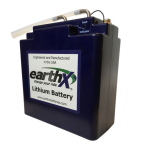- Aircraft Year
- 1974
- Aircraft Type
- 112 Hot Shot
- Reg Number
- N1144J
- Serial Number
- 186

I'm proud to announce a new partnership between RCM Normalizing, and EarthX batteries. EarthX has approved the first Lithium Battery for the certified aircraft market. This represents the potential for nearly a 30lb increase in useful load - a huge step forward for 112 owners! Visit the RCM website for more details about the battery, and the accessories that go with it.
https://rcmnormalizing.com/batteries
